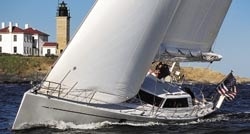
turner56.jpg
When the name of a boat is followed by the Roman numeral VII, you know there’s some experience behind its design parameters. The Turner 56 Brigadoon VII is the latest in a series of boats owned by Bob Morton and his antecedents, and it reflects his desire to include some cruising comforts as adjuncts to the race-winning performance he’s known in all his family’s boats. Turner Yachts of Ontario, Canada, builds boats to meet these needs. The Bill Tripp-designed 56 will provide continued fast rides from Newport to Bermuda for a racing crew, yet still allow family and friends to kick back in a well-appointed interior when in cruising mode.
The 56 sports a raised saloon and an almost flush main deck atop a plainly IMS hull (flat topsides, nearly plumb bow). Twin wheels let the racing helmsman steer from the quarter of his choice and allow the cruising crew free access to the sugar-scoop stern. On passage, the folded and covered inflatable tender fills the big space between the helm seats.
Rob Turner, who was formerly a VP at C&C Yachts before it moved to Ohio, led us through Brigadoon, showing off all of the clever solutions with which he and his team fulfilled the wishes of a very experienced client. For example, a cockpit table large enough to seat the entire crew would be an enormous hindrance when racing. But what if, once the racing was done, at a touch of a button, the center of the cockpit sole rose up on pneumatic cylinders?
Another racing/cruising conflict is that of windward performance versus getting into shallower harbors. The Turner 56 answers with a hydraulically operated keel that lifts at the push of another button to reduce the sailing draft of 12 feet 6 inches to a more harbor-friendly 7 feet 6 inches. A mechanism like that, moving 11,000 pounds of lead at the bottom of a manganese-bronze fin, requires a substantial supporting structure, and that’s amply provided by the gridwork-backed Kevlar/epoxy hull and deck, another Turner specialty.
Twin management stations occupy the starboard side of the saloon. The nav station faces forward, with a laptop computer built into the desktop and wired into the instruments. Forward of it, another built-in laptop controls the rest of the ship’s systems, including the entertainment.
The dining area is to port, elevated over the machinery space, and provides views out of the deckhouse windows. Forward of it, also to port, and at the lower level, is a well-appointed galley, with details like a chef’s knife set that drops into the otherwise dead space under the outboard corner of the countertop. The inboard limit of this U-shaped galley is the mast and the trunk for the lifting keel, which the designers have incorporated so that it doesn’t obtrude into the living areas.
The master suite is forward of the mast. The double berth along the port side of the hull has a bundling board to divide it into two comfortable sea berths, and the head and shower compartments are forward. Aft, under the cockpit, are two guest cabins, each with bundling-board berths for the offwatch. At the foot of the companionway, on the port side, is a compact head.
Bob Morton has also had the boat set up for two to cruise. The 100-percent, roller-furling cruising jib is easy to tack, and full battens, lazy jacks, and a Park Avenue boom tame the big mainsail. Power winches in the cockpit and next to the mast provide muscle.
Owner and builder alike have put their all into creating a boat to fill two roles without compromising either, and our impression on a day of mixed weather on Narragansett Bay is that they’ve succeeded on both counts.








